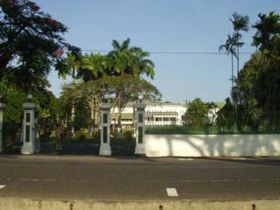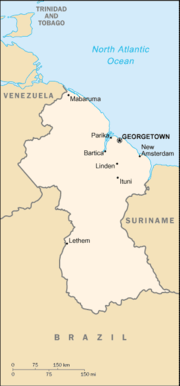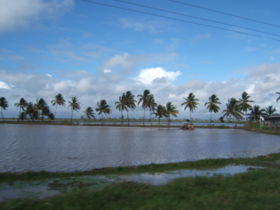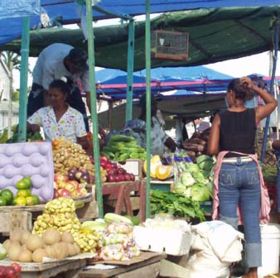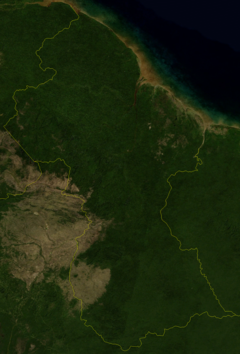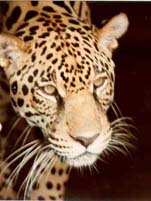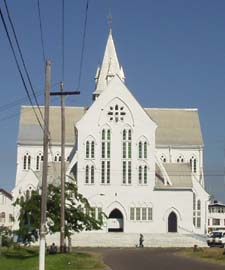Guyana
2007 Schools Wikipedia Selection. Related subjects: Central & South American Countries; Countries
| Co-operative Republic of Guyana | |||||
|
|||||
| Motto: One people, one nation, one destiny | |||||
| Anthem: Dear Land of Guyana, of Rivers and Plains | |||||
| Capital | Georgetown | ||||
|---|---|---|---|---|---|
| Largest city | Georgetown | ||||
| Official languages | English | ||||
| Government | Semi-Presidential Republic | ||||
| - President | Bharrat Jagdeo | ||||
| - Prime Minister | Samuel Hinds | ||||
| Independence | |||||
| - From the UK | May 26, 1966 | ||||
| - Republic | February 23, 1970 | ||||
| Area | |||||
| - Total | 214,969 km² ( 84th) 83,000 sq mi |
||||
| - Water (%) | 8.4 | ||||
| Population | |||||
| - July 2005 estimate | 751,000 ( 162nd) | ||||
| - 2002 census | 751,223 | ||||
| - Density | 3.5/km² ( 217th) 9.1/sq mi |
||||
| GDP ( PPP) | 2005 estimate | ||||
| - Total | $3.489 billion ( 157th) | ||||
| - Per capita | $4,612 ( 105th) | ||||
| HDI (2003) | 0.720 (medium) ( 107th) | ||||
| Currency | Guyanese dollar ( GYD) |
||||
| Time zone | ( UTC-4) | ||||
| Internet TLD | .gy | ||||
| Calling code | +592 | ||||
Guyana ( pronounced [gaɪ'a.na], occasionally Anglicized as [gaɪ'æ.nə]) is the only nation state of the Commonwealth of Nations on the mainland of South America. It is north of the Equator but in the tropics and has an atlantic coast. Guyana is bordered to the east by Suriname, to the south and southwest by Brazil and to the west by Venezuela. It is the third smallest country on the mainland of South America and approximately the size of Great Britain. Guyana is the only South American country whose official language is English, and is one of only two remaining countries in the mainland Americas to drive on the left.
The official name of Guyana is the Co-operative Republic of Guyana. Guyana is an Amerindian word meaning Land of Many Waters. The country can be characterized by its vast rain forests dissected by numerous rivers, creeks and waterfalls, notably Kaieteur Falls on the Potaro River. Guyana's tepuis are famous for being the inspiration for Sir Arthur Conan Doyle's 1912 novel The Lost World. The country enjoys a friendly, multicultural society, high floral and faunal biodiversity, prize-winning rum, British Colonial architecture and Demerara sugar.
Though physically part of South America, culturally Guyana is Caribbean rather than Latin American and it is considered part of the West Indies. Other languages of Guyana include Creolese, Hindi, Wai-Wai, Arawak and Macushi.
Guyana is currently in a border dispute with Suriname, which claims the land east of the Corentyne River in southeastern Guyana. Venezuela claims the land west of the Essequibo River as part of Guayana Esequiba.
History
At the time the first Europeans arrived in the area around 1500, Guyana was inhabited by Arawak and Carib tribes of Amerindians. Although Guyana was first sighted by Christopher Columbus during his third voyage, it was not settled by Europeans until the Dutch in 1616, who established three separate colonies; Essequibo ( 1616), Berbice ( 1627), and Demerara ( 1752). The British assumed control in the late 18th century and the Dutch formally ceded the area in 1814. The three became a single British colony known as British Guiana in 1831.
Escaped slaves formed Maroon communities. The abolition of slavery in 1834 led to black settlement of urban areas and the importation of indentured laborers from Madeira (Portugal) (beginning in 1834), Germany (first in 1835), Ireland (1836), Scotland (1837), Malta (1839), China and India (beginning in 1838) to work on the sugar plantations. In 1889 Venezuela claimed the land up to the Essequibo. Ten years later an international tribunal ruled the land belonged to British Guiana; however, the dispute continues
During the Second World War, the U.S. made an agreement that gave its airforce access to British airports in South America and brought it into the war against Germany. Soon after that it also went to war against the Japanese Empire following Pearl Harbour
Guyana achieved independence from the United Kingdom in 1966 and became a republic in 1970, remaining a member of the Commonwealth. The CIA and United States State Department along with the British government played a strong covert role in influencing who would politically control Guyana during this time.
Geography
Guyana can be divided into five natural regions: a narrow and fertile marshy plain along the Atlantic coast where most of the population lives, then a white sand belt more inland, containing most of Guyana's mineral deposits, the dense rainforests across the middle of the country, the grassy flat savannah in the south and finally the larger interior highlands consisting mostly of mountains that gradually rise to the Brazilian border. Guyana's main mountains are contained here, including Mount Ayanganna (6,699 ft; 2,042 m) and on Mount Roraima (9,301 ft; 2,835 m - highest mountain in Guyana) on the Brazil-Guyana-Venezuela tripoint, part of the Pakaraima range. Roraima is said to be have been the inspiration for The Lost World. There are also many steep escarpments and waterfalls, including the famous Kaieteur Falls. Between the Rupununi River and the border with Brazil lies the Rupununi savannah, south of which lie the Kanuku Mountains. Guyana is the only country in South America that is part of the West Indies (Caricom Treaty).
There are many rivers in the country, the three main ones being (west to east) the Essequibo, the Demerara, and the Berbice. There is also the Corentyne along the border with Suriname. At the mouth of the Essequibo are several large islands. The 90 mile (145 km) Shell Beach along the north-west coast of Guyana is a major breeding area for turtles and other wildlife.
The local climate is tropical and generally hot and humid, though moderated by northeast trade winds along the coast. There are two rainy seasons, the first from May to mid-August, the second from mid-November to mid-January.
Demographics
Guyana's population of 751,223 is diverse: the three largest groups are the Indians or Indo-Guyanese (43.5% in 2002) who have remained predominantly rural, the Africans or Afro-Guyanese (30.2%) who constitute the majority urban population, and those of mixed origin (16.7%). The Amerindians (9.2%) who live in the country's interior, are divided into a number of different groups, the main ones being the Akawaio, Arawak, Carib, Macushi, Makuxi, Pemon and Wapishana. Several smaller groups, including Chinese, "Whites" and others make up less than 1% of the population. The overwhelming majority of the population - around 90% - live along the coastal strip, where population density is more than 298 persons per square mile (115/km²). There is much racial tension between the Indian and African communities, and the two main parties are largely mono-racial. The trend over time is for the Amerindian and mixed-race proportion to grow, mainly at the expense of the Indo-Guyanese proportion, while the black percentage remains roughly stable. In 1980, Guyana had an absolute majority (51.9%) of Indo-Guyanese, but now no group forms a majority.
Religion in Guyana runs mainly along racial lines. Christianity, practiced mainly by Afro-Guyanese and mixed-origin citizens, makes up about 50% of Guyana and it is Guyana's largest religion. Hinduism, primarily practiced by Indo-Guyanese, is the faith of 35% of the population, and Islam is the faith of 10%. Guyana also has a Bahá'í population at 5%.
Emigration has been a large and persistent problem in Guyana, with an estimated 500,000 Guyanese living abroad. Since independence, as many as 10,000 Guyanese per year have left and settled permanently in the United States alone and demand to emigrate remains very high. The number of legal immigrants to the U.S. is the highest in South America (astonishing considering Guyana's small population) and the rate of illegal migration is believed to be high as well. Most legal immigrants are sponsored by family members in the United States, few immigrate based on job skills. Canada, the United Kingdom and English-speaking Caribbean islands are the other main countries people choose to emigrate to. At the same time, the birth rate has fallen sharply, and because of the emigration, can no longer sustain the country's population level. Many in the government worry that the country may become depopulated, but few concrete steps have been taken to stem the outflow. Results from the 2002 census, however, suggest that emigration in the last decade has decreased somewhat compared to the 1980s.
Emigration from Guyana to the United States
- 1986–1990: 52,649
- 1991–1995: 44,138
- 1996–2000: 29,711
- 2001–2005: 40,695
There are over 500,000 Guyanese in the US and Canada compared to 750,000 in Guyana.
Economy
The main economic activities in Guyana are agriculture (producing rice and Demerara sugar), bauxite mining, gold mining, timber, shrimp and minerals. The sugar industry, which accounts for 28% of all export earnings, is largely run by Guysuco which employs more people than any other industry. Many industries have a large foreign investment. The mineral industry, for example, is heavily invested in by the American company Reynolds Metals and the Canadian Alcan and the Korean/Malaysian Barama Company has a large stake in the logging industry.
The Guyanese economy has exhibited moderate economic growth since 1999, based on an expansion in the agricultural and mining sectors, a more favorable atmosphere for business initiatives, a more realistic exchange rate, fairly low inflation, and the continued support of international organizations. Chronic problems include a shortage of skilled labor and a deficient infrastructure. The government is juggling a sizable external debt against the urgent need for expanded public investment. Low prices for key mining and agricultural commodities combined with troubles in the bauxite and sugar industries threaten the government's already tenuous fiscal position and dim prospects for the future.
The production of balatá was once big business in Guyana. Most of the balata bleeding in Guyana took place in the foothills of the Kanuku Mountains in the Rupununi. Early exploitation also took place in the North West District, but most of the trees in the area were destroyed by illicit bleeding methods that involved cutting down the trees rather than making incisions in them.
Folk uses of balata included the making of homegrown cricket balls, temporarily filling of troublesome tooth cavities, and the crafting of figurines and other decorative items (particularly by the Macushi people of the Kanuku mountains).
Major private sector organizations include the Private Sector Commission (PSC) and the Georgetown Chamber of Commerce & Industry (GCCI); see a list of companies in Guyana.
Economic Summary - GDP/PPP (2004 est.): $2.899 billion; per capita $3,800. Real growth rate: 1.9%. Inflation: 4.5%. Unemployment: 9.1% (2000) (understated). Arable land: 2%. Labor force: 418,000 (2001 est.); agriculture n.a., industry n.a., services n.a. Agriculture: sugar, rice, wheat, vegetable oils; beef, pork, poultry, dairy products; fish, shrimp. Industries: bauxite, sugar, rice milling, timber, textiles, gold mining. Natural resources: bauxite, gold, diamonds, hardwood timber, shrimp, fish. Exports: $570.2 million (f.o.b., 2004 est.): sugar, gold, bauxite/alumina, rice, shrimp, molasses, rum, timber. Imports: $650.1 million (f.o.b., 2004 est.): manufactures, machinery, petroleum, food. Major trading partners: Canada, U.S., UK, Portugal, Belgium, Jamaica, Trinidad and Tobago, Italy, Cuba (2003)
Communications - Telephones: Main lines in use: 102,700 (2004 - source: ITU); Mobile cellular: 219,000 (Sep 2005 - source: Informa Telecoms). Radio broadcast stations:1 (government owned, broadcasting on AM, FM, and shortwave) The government has refused to grant radio licenses to private operators (1998). Television broadcast stations: 14 (one government owned station; twelve private stations which relay a variety of American programmes via satellite services) (2005). Internet hosts : 642 (2004 - source: ITU). Internet users: 145,000 (2004 - source: ITU).
Transportation - Railways: total: 116 miles (187 km)—all dedicated to ore transport—(2001 est.). Highways: total: 4,952 miles (7,970 km); paved: 367 miles (590 km); unpaved: 4,586 miles or 7,380 kilometres (1999 est.). Waterways: 669 miles (1,077 km); note: Berbice, Demerara, and Essequibo rivers are navigable by oceangoing vessels for 93 miles (150 km), 62 miles (100 km), and 50 miles (80 km) respectively (2004). Ports and harbors: Georgetown. Airports: 1 international airport ( Cheddi Jagan International Airport, Timehri), 1 upgraded regional airstrip at Ogle and numerous (49) small airstrips along the coast and in interior locations (2004 est.). See Transport in Guyana. There are no flying boats in Guyana
Society
Culture
| Date | English Name |
|---|---|
| January 1 | New Year's Day |
| February 23 | Mashramani-Republic Day |
| Variable | Phagwah |
| Variable | Eid-ul-Fitr |
| Variable | Good Friday |
| Variable | Easter Monday |
| May 1 | Labour Day |
| May 5 | Indian Arrival Day |
| May 26 | Independence Day |
| First Monday in July | CARICOM Day |
| August 1 | Emancipation Day |
| Variable | Diwali |
| December 25 | Christmas |
| December 26 or 27 December | Boxing Day |
Guyana's culture is very similar to that of the English-speaking Caribbean. It is so similar that Guyana is included and accepted as a Caribbean Nation and is a member of the Caribbean Community Caricom economic bloc.It is one of the four nations that founded the Caribbean Community. Only its geographical location differentiates it from the rest of the English speaking Caribbean countries. Guyana shares similar interests with the islands in the West Indies, such as food, festive events, music, sports, etc. Guyana plays international cricket as a part of the West Indies cricket team, and the Guyana team plays first class cricket against other nations of the Caribbean. Further adding to its distinction as a member of the Caribbean community, Guyana is a member of CONCACAF, the international football federation for North and Central America and the Caribbean. Another aspect of Guyanese culture is its rich folklore about Jumbees.
Music & Entertainment in Guyana follows the lead of other Caribbean countries and India. Radio stations play the latest rap, reggae, dancehall, soca and chutney music, as well as Bollywood influences of bhangra and other Hindi music. Local television stations air American, British and Indian broadcasts. Night clubs in Georgetown belt out the latest music late into the night on weekends.
See: Music of Guyana
Cuisine and Recipes
For the main article, see wikibooks:Cookbook:Cuisine of Guyana
Cultural events in Guyana
- Mashramani (Mash)
- Phagwah ( Holi)
- Deepavali ( Diwali)
The major religions in Guyana include Christianity, comprising 50% of the population, Hinduism at 35% and Islam with 10% of the population. The remaining 5% consist of Bahai, and indigenous religious beliefs.
Sport in Guyana The major sports in Guyana are cricket (Guyana is part of the West Indies as defined for international cricket purposes), softball cricket ( beach cricket) and soccer. The minor sports in Guyana are netball, rounders, lawn tennis, basketball, table tennis, boxing, and a few others.
Languages English (official language), Amerindian languages (see Cariban languages), Guyanese Creole, Hindustani (Hindi- Urdu).
Politics
Politics of Guyana takes place in a framework of a semi-presidential representative democratic republic, whereby the President of Guyana is the head of government, and of a pluriform multi-party system. Executive power is exercised by the government. Legislative power is vested in both the government and the National Assembly of Guyana. The Judiciary is independent of the executive and the legislature.
Guyana is divided into 10 administrative regions.
Education
Guyana's educational system, which at one time was considered to be among the best in the Caribbean, deteriorated in the 1980s due to the emigration of highly educated citizens and the lack of appropriate funding. Although the education system had displayed a remarkable recovery in the 1990s, it still does not produce the quality of educated students necessary for Guyana to modernize its workforce. The country lacks a critical mass of expertise in many of the disciplines and activities of which it depends.
The educational system does not sufficiently focus on the training of Guyanese in science and technology, technical and vocational subjects, business management, nor computer sciences. The Guyanese education system is modelled after the former British education system. Students are expected to write SSEE by the time they are 10-11, prior to commencing high school and GCE at the end of high school. The retention of the O and A level systems used from colonial times has remained in all school within the country. The reason for the insufficient focus or various disciplines can be directly attributed to the common choices made by students to specialize in areas that are similar (math/chemistry/physics or geography/history/economics)
There are wide disparities among the geographical regions of the country in the availability of quality education and the physical facilities which are provided are in poor condition.
Further adding to the problems of the educational system, many of the better-educated professional teachers have emigrated to other countries over the past two decades, mainly due to low pay, lack of opportunities and crime. As a result, there is a dearth of trained teachers at every level of Guyana's educational system.
Public health
Delivery of services
The delivery of health services is provided at five different levels in the public sector:
- Level I: Local Health Posts (166 in total) that provide preventive and simple curative care for common diseases and attempt to promote proper health practices. Community health workers staff them.
- Level II: Health Centres (109 in total) that provide preventive and rehabilitative care and promotion activities. These are ideally staffed with a medical extension worker or public health nurse, along with a nursing assistant, a dental nurse and a midwife.
- Level III: Nineteen District Hospitals (with 473 beds) that provide basic in-patient and outpatient care (although more the latter than the former) and selected diagnostic services. They are also meant to be equipped to provide simple radiological and laboratory services, and to be capable of gynecology, providing preventive and curative dental care. They are designed to serve geographical areas with populations of 10,000 or more.
- Level IV: Four Regional Hospitals (with 620 beds) that provide emergency services, routine surgery and obstetrical and gynecological care, dental services, diagnostic services and specialist services in general medicine and pediatrics. They are designed to include the necessary support for this level of medical service in terms of laboratory and X-ray facilities, pharmacies and dietetic expertise. These hospitals are located in Regions 2, 3, 6 and 10.
- Level V: The National Referral Hospital (937 beds) in Georgetown that provides a wider range of diagnostic and specialist services, on both an in-patient and out-patient basis; the Psychiatric Hospital in Canje; and the Geriatric Hospital in Georgetown. There is also one children’s rehabilitation centre.
This system is structured so that its proper functioning depends intimately on a process of referrals. Except for serious emergencies, patients are to be seen first at the lower levels, and those with problems that cannot be treated at those levels are referred to higher levels in the system. However, in practice, many patients by-pass the lower levels.
The health sector is currently unable to offer certain sophisticated tertiary services and specialised medical services, the technology for which is unaffordable in Guyana, or for which the required medical specialists simply do not exist. Even with substantial improvements in the health sector, the need for overseas treatment for some services might remain. The Ministry of Health provides financial assistance to patients requiring such treatment, priority being given to children whose condition can be rehabilitated with significant improvements to their quality of life.
In addition to the facilities mentioned above, there are 10 hospitals belonging to the private sector and to public corporations, plus diagnostic facilities, clinics and dispensaries in those sectors. These 10 hospitals together, provide for 548 beds.
18 clinics and dispensaries are owned by GUYSUCO.
The Ministry of Health and Labour is responsible for the funding of the National Referral Hospital in Georgetown, which has recently been made a public corporation managed by an independent Board. Region 6 is responsible for the management of the National Psychiatric Hospital. The Geriatric Hospital, previously administered by the Ministry of Labour, became the responsibility of the Ministry of Human Resources and Social Security in December 1997.
Health conditions
One of the most unfortunate consequences of Guyana's economic decline in the 1970s and 1980s due to the rule of the PNC(PeoplesNationalCongress) was that it led to very poor health conditions for a large part of the population. Basic health services in the interior are primitive to non-existent and some procedures are not available at all. The U.S. State Department Consular Information Sheet warns "Medical care is available for minor medical conditions. Emergency care and hospitalization for major medical illnesses or surgery is limited, due to a lack of appropriately trained specialists, below standard in-hospital care, and poor sanitation. Ambulance service is substandard and may not routinely be available for emergencies." Many Guyanese seek medical care in the United States, Trinidad or Cuba.
Compared to other neighbouring countries, Guyana ranks poorly in regard to basic health indicators. In 1998, life expectancy at birth was estimated at 66.0 for Guyana, 71.6 for Suriname, 72.9 for Venezuela; 73.8 for Trinidad and Tobago, 74.7 for Jamaica, and 76.5 for Barbados. In Guyana, the infant mortality rate in 1998 was 24.2, in Barbados 14.9; in Trinidad and Tobago 16.2; in Venezuela 22; in Jamaica 24.5; and in Suriname 25.1.
Maternal mortality rates in Guyana are also relatively high, being estimate at 124.6 for 1998. Comparable figures for other Caribbean countries are 50 for Barbados, 75 for Trinidad and 100 for Jamaica.
It must be emphasized, however, that although Guyana's health profile still suffers in comparison with most of the Caribbean, there has been remarkable progress between 1988 and 1998
In Guyana the leading causes of mortality for children under the age of one are: certain conditions originating in the prenatal period (46.9%); intestinal infectious diseases (15.6%); congenital anomalies (10.4%); diseases of the respiratory system (6.7%); nutritional deficiencies 5.8%); bacterial diseases (4.0%); diseases of the blood and the blood-forming organs (2.0%); endocrine and metabolic disease immunity disorders (1.8%); accidents (1.6%); and diseases of the Nervous System (1.1%).
The leading causes of mortality for all age groups are cerebrovascular diseases (11.6%); ischemic heart disease (9.9%); immunity disorders (7.1%); diseases of the respiratory system (6.8%); diseases of pulmonary circulation and other forms of heart disease (6.6%); endocrine and metabolic diseases (5.5%); diseases of other parts of the Digestive System (5.2%); violence (5.1%); certain condition originating in the prenatal period (4.3%); and hypertensive diseases (3.9%).
The picture in regard to morbidity patterns differs. The ten leading causes of morbidity for all age groups are, in decreasing order: malaria; acute respiratory infections; symptoms, signs and ill defined or unknown conditions; hypertension; accident and injuries; acute diarrhoeal disease; diabetes mellitus; worm infestation; rheumatic arthritis; and mental and nervous disorders.
This morbidity profile indicates that it can be improved substantially through enhanced preventive health care, better education on health issues, more widespread access to potable water and sanitation services, and increased access to basic health care of good quality.
Biodiversity
Guyana abounds with plant and animal life. Each region boasts unique species.
The following habitats have been categorised for Guyana: coastal, marine, littoral, estuarine palustrine, mangrove, riverine, lacustrine, swamp, savannah, white sand forest, brown sand forest, montane, cloud forest, moist lowland and dry evergreen scrub forests (NBAP, 1999). About 14 areas of biological interest have been identified as possible hotspots for a National Protected Area System.
More than 80% of Guyana is still covered by forests, ranging from dry evergreen and seasonal forests to montane and lowland evergreen rain forests. These forests are home to more than 1,000 tree species. Guyana’s tropical climate, unique geology, and relatively pristine ecosystems support extensive areas of species-rich rain forests and natural habitats with high levels of endemism. Approximately 8,000 species of plants occur in Guyana, half of which are found nowhere else.
Numbers of fauna species are correspondingly high. Guyana, with 1,168 vertebrates, boasts one of the richest mammalian fauna assemblages of any comparably sized area in the world.
The Guiana Shield region is little known and extremely rich biologically. Unlike other areas of South America, over 70% of the natural habitat remains pristine.
The rich natural history of British Guiana was described by early explorers Sir Walter Raleigh and Charles Waterton and later by naturalists Sir David Attenborough and Gerald Durrell.
See Category:Flora of Guyana, Category:Fauna of Guyana
Ecology and World Heritage Site status
Countries interested in the conservation and protection of natural and cultural heritage sites of the world accede to the Convention Concerning the Protection of the World Cultural and Natural Heritage that was adopted by UNESCO in 1972. Guyana is no exception, and signed the treaty in 1977. In fact, Guyana was the first Caribbean State Party to sign the treaty. Sometime in the latter half of the mid-1990s Guyana seriously began the process of selecting sites for World Heritage nomination and three sites were considered: Kaieteur National Park, Shell Beach and Historic Georgetown. By 1997, work on Kaieteur National Park was started and in 1998 work on Historic Georgetown was begun. To date, however, Guyana has not made a successful nomination.
In 2000(?) Guyana submitted the Kaieteur National Park, including the Kaieteur Falls, to UNESCO as its first World Heritage Site nomination. The proposed area and surrounds have some of Guyana’s most diversified life zones with one of the highest levels of endemic species found anywhere in South America. The Kaieteur Falls is the most spectacular feature of the park falling a distance of 226 m and exceeding the height of Niagara Falls (USA/Canada) five times. Unfortunately, the nomination of Kaieteur Park as a World Heritage Site was not successful, primarily because the area was seen by the evaluators as being too small, especially when compared with the Central Suriname Nature Reserve that had just been nominated as a World Heritage Site (2000). The dossier was thus returned to Guyana for revision.
Guyana continues in its bid for a World Heritage Site. Work continues, after a period of hiatus, on the nomination dossier for Historic Georgetown – a Tentative List indicating Historic Georgetown as being put forward for nomination was submitted to UNESCO in December 2004. There is now a small committee put together by the Guyana National Commission for UNESCO to complete the nomination dossier and the management plan for the site. Recently, in April 2005, two Dutch experts in Conservation spent two weeks in Georgetown supervising Architecture staff and students of the University of Guyana in a historic building survey of the selected area. This is part of the data collection for the nomination dossier. It is expected that the completed nomination document will be submitted in 2006.
Meanwhile, as a result of the Kaieteur National Park being considered too small, there is a proposal to prepare a nomination for a Cluster Site that will include the Kaieteur National Park, the Iwokrama Forest and the Kanuku Mountains. The Iwokrama Rain Forest, an area rich in biological diversity, has been described by Major General (Rtd) Joseph Singh as “a flagship project for conservation.” The Kanuku Mountains area is in a pristine state, and is home to more than 400 birds and animals. These three sites together, we feel, more than adequately meet the requirements of exceptional natural beauty and biological diversity, as well as the requirements of size and integrity, for a successful nomination.
There is much work to be done for the successful nomination of these sites to the World Heritage List. The State, the private sector and the ordinary Guyanese each have a role to play in this process and in the later protection of the sites. Inscription on the UNESCO World Heritage will open Guyana to more serious tourists thereby assisting in its economic development.
Guyana exhibits two of the WWF's Global 200 ecoregions most crucial to the conservation of global biodiversity, Guianan moist forests and Guyana Highlands moist forests and is home to several endemic species including the tropical hardwood Greenheart (Chlorocardium rodiei).
Landmarks
- St. George's Anglican Cathedral - Was the tallest wooden building in the world at the time of construction. Now dwarfed by other structures such as the Todaiji Temple in Japan.
- Demerara Harbour Bridge - Was the longest floating bridge in the world. Now the fourth longest floating bridge in the world.
- Kaieteur Falls - The tallest single-drop falls and one of the most spectacular waterfalls in the world.
- Caribbean Community (CARICOM) Building - houses the largest and most powerful political union in the Caribbean.
- Providence Stadium - Under construction on the east bank of the Demerara River for the ICC World Cup 2007. Construction has started. When completed it will be a major spot for leisure in Guyana. It will also be near the Providence Mall which, when completed, will be the largest mall in Guyana.
- Guyana International Conference Centre - presented as a gift from the People's Republic of China to the Government of Guyana. It is the only one of its kind in the country.
- Stabroek Market - A large cast iron colonial structure located next to the Demerara River.
- The Town Hall - A beautiful wooden structure also from the colonial era.
Military
Military branches: Guyana Defence Force (GDF; includes Ground Forces, Coast Guard, and Air Corps), Guyana People's Militia (GPM), Guyana National Service (GNS), Guyana Police Force
Military manpower - availability:
males age 15–49: 206,199 (2002 est.)
Military manpower - fit for military service:
males age 15–49: 155,058 (2002 est.)
Military expenditures - dollar figure: $7 million (FY94)
Military expenditures - percent of GDP: 1.7% (FY94)
Human Rights
Guyana is the only country in South America where homosexual sex is illegal.
Trivia
- The 1856 British Guiana 1c magenta stamp is considered the rarest in the world, with only one copy known to exist (the other having been destroyed by a previous owner).
- The 1959 film Green Mansions, starring Audrey Hepburn and Anthony Perkins, was filmed in Guyana (then British Guiana).
- Guyana is the only South American country where the death penalty is still in use for serious crimes and where homosexuality was once illegal.
- On November 18, 1978, the Jonestown Massacre took place in the jungle of Northwest Guyana; 912 members of the Peoples Temple cult died in a mass suicide.
- The Guinness Book of Records (1990 ed) lists the Guyanese born Sir Lionel Luckhoo as "the world's most successful lawyer" because he obtained 245 consecutive acquittals for his clients that were accused of murder.
- Guyanese people say that if you visit Guyana and "Eat Labba and Drink Black Water", you are bound to return to Guyana. (Labba is a small agouti or South American rodent that is eaten in a dark stew called "pepper pot", "Black water" is the water found in the many creeks in the interior of Guyana, made black by tannin found in rotting vegetation).
- In the fictional universe of the Pokemon series of video games, it has been stated that the Legendary Pokemon Mew was first discovered deep in jungles of Guyana.
- British Politician Peter Mandelson on a visit to Guyana is said to have been misheard as asking for labba curry when in fact he was asking for the lavatory.



